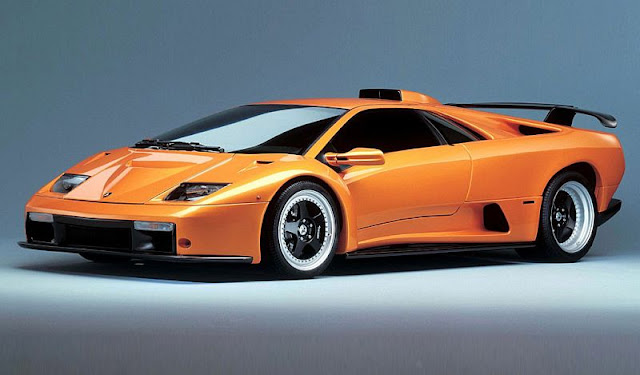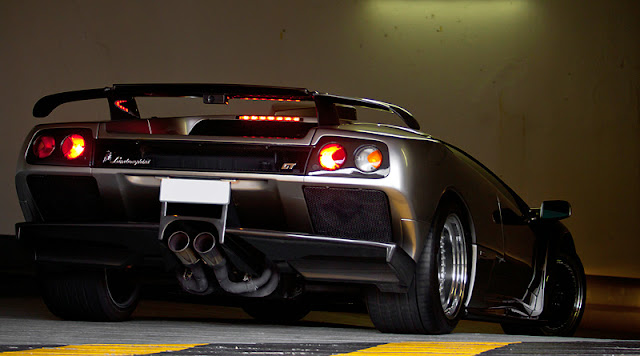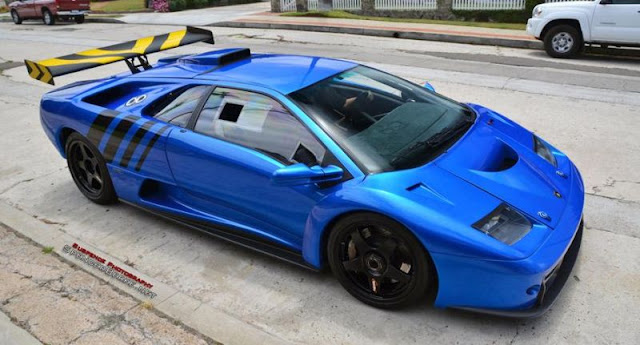car, cars, bmw, mercedes, automobiles, nissan, new cars, porsche, ferrari, lotus, audi sports cars, nissan cars, luxury car, exotic car, new sports car, fastcars, new sport cars, sports car
Friday, February 29, 2008
Lamborghini Diablo, part 5
The Lamborghini Diablo GT (Gran Turismo) is a high-performance sports car built by Italian automaker Lamborghini in 1999. The Diablo GT was only and officially sold in Europe. Eighty models were built. The Diablo GT's price is estimate at $300,000.
As the SV (Sport Veloce) was already a near race-ready version of the Diablo, the limited run GT model went even further in the same direction. It boasted a modified version of the V12 engine, bored out to 6.0 litres and producing 575 hp (429 kW), while enlarged brakes, an improved and lower-riding suspension and owner-specific gearing were other mechanical changes. More aggressive bodywork with flared fenders and wider wheels was introduced.
Lamborghini Diablo GT combines a new construction technology with a new design. Almost all the body parts are made of carbon fibre, excluding the roof and the doors only. Front bumper of new design, with integrated air intakes for the new front mounted oil cooler and for the brakes. Rear bumper of new design, "wing shaped". Front fenders of new design, matching the larger front track. Front bonnet of new design, with integrated air outlet from the oil cooler. Engine bonnet of new design, incorporating the engine dynamic air intake.
Diablo GT's 6 litre V12 engine, particularly conceived for superior performance (max power 567 hp (423 kW) at 7300 rpm, max torque 630 N·m (465 ft·lbf) at 5500 rpm). The Multi-throttles intake manifold ("individual intake system": one throttle unit per each cylinder), with improved runners for high flow coefficients. GT's new intake and exhaust camshafts, tuned to achieve very high charge efficiency at medium-high engine speeds. Diablo GT's intake variable valve timing system (derived from the well proven system already used on Diablos model year '98 and '99) in order to guarantee good charge efficiency and then good torque not only at high but also at low engine speeds. The dynamic air inlet duct upstream the intake plenum for additional improvements of charge density and then engine power with the increasing of car speed aluminum construction (as Lamborghini's tradition) with magnesium intake manifold and cylinder head covers titanium connecting rods and lighter crankshaft.
The brake and the ABS systems are derived from the well proven high performance systems of the Diablo range with self ventilated large diameter discs (355 mm front, 335 mm rear) with high performance calipers and last generation ABS system. For Lamborghini Diablo GT even better performances are achieved, all because of the reduced car weight.
Most components in the interior are constructed of carbon fibre. Racing seats, racing 4 point safety belts, sports steering wheel and general sports trimming, leather and alcantara upholstery, carbon fibre parts "in sight", are elements that add to the already sporty feel. The air conditioning system is standard equipment to maintain a high comfort level. A dual air bag system is available as an option. As of the International Automobil Show of Frankfurt (September 1999), an optional rear wing mounted camera system became available to assist with reversing. The system comes complete with a display on the centre console which can also be used for GPS navigation.
technorati tags: lamborghini diablo 2007, 1998 lamborghini diablo, 1999 lamborghini diablo, lamborghini diablo roadster, lamborghini diablo vt, lamborghini prices, lamborghini price, 2007 lamborghini, car, car performance, diablo roadster
Thursday, February 28, 2008
Lamborghini Diablo, part 4

The second version of the VT coupé and roadster added mostly cosmetic and styling changes. The cars now featured the SV's exposed headlamps (Borrowed from the Nissan 300zx 1990-96, and Used under licence) , new wheels and a newly redesigned dashboard. On the mechanical side, larger brakes, the addition of ABS brakes and a new variable valve timing system on the 5.7-litre V12 were the only mechanical updates. Power output increased to 530 hp (395 kW), The standard 0-100Kmh time was 3.8 seconds but if you rev up to 6000 Rpm and sidestep the clutch you can launch it in 3.6 seconds.. Despite the money Lamborghini had spent making the updates, the "Version 2" VTs were discontinued after only one year of production.
Just like the updated versions of the VT coupé and roadster, the 1999 model year SV's changes were primarily limited to cosmetics. It received slight bodywork updates (keeping the exposed headlamps), new wheels and larger brakes in addition to the new VVT-equipped, 530 hp (395 kW) engine. The 1999 Diablos also gained a new dashboard. Instead of the traditional flat dashboard with a separate upright instrument binnacle, as on so many Italian supercars, the new dash was of a more fluid, wave shaped design. A thin strip of black glass runs the length of the dash, and instruments lights such as main beam, headlight operation and low fuel warning appear within this strip. The concept was inspired by Bang & Olufsen Hi-Fi products.
Otherwise, the 1999 Diablo remained fundamentally unchanged. Like the updated VT, it was produced only as a production model for the 1999 model year. A limited edition 2000 model was produced, available only in metallic silver - most of these cars are in the United States.
technorati tags: lamborghini diablo 2007, 1998 lamborghini diablo, 1999 lamborghini diablo, lamborghini diablo roadster, lamborghini diablo vt, lamborghini prices, lamborghini price, 2007 lamborghini, car, car performance, diablo roadster
Posted by
SabrebIade
at
9:27 AM
No comments:
 Labels:
cars,
classic,
exotic cars,
lamborghini,
lamborghini diablo,
sports cars,
supercars
Labels:
cars,
classic,
exotic cars,
lamborghini,
lamborghini diablo,
sports cars,
supercars
Tuesday, February 19, 2008
Lamborghini Diablo, part 3

The SV or "Sport Veloce" variant of the Diablo was an optional add-on package to the base car. It lacked the VT's all-wheel-drive system and electronic suspension, but it featured the VT's revised dashboard and larger brakes, a new 3-piece adjustable spoiler and was powered by a modified version of the 5.7-litre V12 producing 510 hp (380 kW). The car's air intakes were slightly differently shaped, and from 1999 onwards the vehicle had exposed headlamps as opposed to the pop-up units previous versions used.
Tuning company Koenig-Specials of Germany produced a tuned variant of the SV featuring further suspension modifications, massive brakes and a twin-turbocharger system, boosting the car's output to over 800 hp (597 kW).
Unveiled at the 1996 Geneva Salon, the SVR variant is a lightweight competition version of the SV, built for its pro-am one make series known as Diablo Supertrophy, which was intended to run for three years, with its inaugural round held as the support race to the 1996 24 Hours of Le Mans.
The SVR is 191kg less than the SV (1385kg) and boasts 540 hp (403 kW), mainly of a revised fuel injection timing and is the first Diablo to use variable valve timing. There are numerous noticeable cosmetic differences, the covered lights or sometimes is used in place of its usual retractable headlights. Other cosmetic differences includes, a deeper front spoiler, side skirts and a redesigned rear valance. Also the most visible modification is a fully adjustable rear aerofoil, lightweight acrylic side windows is used in place of a glass items and a set of 18-inch OZ Racing one-piece hollow spoke cast magnesium wheels Each car sold, came with a seasons factory support and an entry to the one-make series. All repairs and maintenance was carried out by Lamborghini themselves.
The series first title winner was BPR regular, Thomas Bscher, who became involved with the business side of the brand in later years. In total, 31 versions of this model have been produced altogether. Only a few of these have been modified for road use.
Posted by
SabrebIade
at
11:32 AM
No comments:
 Labels:
2007 lamborghini,
car,
car performance,
classic,
diablo,
fast car,
lamborghini,
lamborghini diablo,
lamborghini diablo sv,
lamborgini diablo
Labels:
2007 lamborghini,
car,
car performance,
classic,
diablo,
fast car,
lamborghini,
lamborghini diablo,
lamborghini diablo sv,
lamborgini diablo
Wednesday, February 13, 2008
Lamborghini Diablo, part 2

A lightened, hard-edged racing variant of the standard Diablo, the SE30 was sold in limited numbers during 1994 to celebrate Lamborghini's 30th anniversary. The 'SE' stands for Special Edition.
In total just 150 cars were made, eight of which were right hand drive (RHD). In 1995 Lamborghini introduced the SE30 Jota; the Jota was produced from the Lamborghini factory but SE30 owners also had the option of having Lamborghini upgrade their SE30 to Jota specifications. The Jota upgrade consisted of two roof mounted air scoops, a re-tuned L.I.E. chip and a six-speed all-synchromesh gearbox if the Diablo was made at the Lamborghini factory. With these upgrades in place the Diablo SE30 Jota could produce 595 bhp, 72 more than the SE30's 523 bhp. In total only 28 Jota upgrade kits were made but 1 of these was not installed. Contradictory to this, it is believed that only 12 Jotas were actually made (10 in LHD, 2 in RHD); this figure may have come from the number of models made by Lamborghini itself. As an interesting side note about the Jota, Jay Kay (lead singer of Jamiroquai), featured the sound of this car in the intro to a track, called "Travelling without moving" on the band's album of the same name.
The car went without most of the Diablo's standard equipment, meaning that it was devoid of a radio, air-conditioning or sound insulation and featured carbon fiber molded seats, helping to make it 125 kilograms lighter than the standard car. Lamborghini chose to do without the VT's advanced electronic suspension or all-wheel-drive systems, but the car did get an advanced adjustment system controlled with an interior dial that could instantaneously adjust the stiffness of the car's front and rear anti-roll bars. They also enlarged the brake discs of all four wheels, but the car still lacked ABS.
Posted by
SabrebIade
at
12:42 PM
No comments:
 Labels:
classic,
Jota,
Lamborghini SE30,
lamborgini,
lamborginis
Labels:
classic,
Jota,
Lamborghini SE30,
lamborgini,
lamborginis
Subscribe to:
Posts (Atom)
Popular Posts
-
The Clampett Family Truck - The 1921 flatbed Oldsmobile four-cylinder truck with roped-down hood and glass-less headlights seen at the beg...
-
The Challenger name has been carried by three different Dodge models since it was introduced in 1970. While the new Challenger model has cre...
-
The Porsche 968 was an automobile sold by Porsche AG of Germany from 1992 to 1995 and marketed as the replacement for the Porsche 944. When ...
-
Comfort, style and speed. The Mercedes-Benz CL65 AMG is powered by a 6.0 litre V12 BiTurbo engine that puts out 612 horsepower and 737 foo...
-
The second version of the VT coupé and roadster added mostly cosmetic and styling changes. The cars now featured the SV's exposed headl...
-
The worlds fastest Lamborghini may be a toss up. In one corner we have the Lamborghini Murciélago LP640. The Murciélago is powered by a 6...
-
The Ferrari Testarossa F512 M is a 12-cylinder mid-engine sports car manufactured by Ferrari. The F512 M was powered by a 4.9 litre (302 ...
-
Launched in 2000, the Ferrari 360 Spider is powered by a mid-mounted 3.6 liter V8 with 400 horsepower, shown off under a glass hood. Thi...
-
Aston Martin V12 Vanquish - Die Another Day For Pierce Brosnan's last outing as 007, Bond returns to an Aston Martin - and this one is m...
-
My second favorite Bel Air, the 1955. You could get a V8 engine option in 1955 and the 2 speed Powerglide automatic, or a standard three spe...












